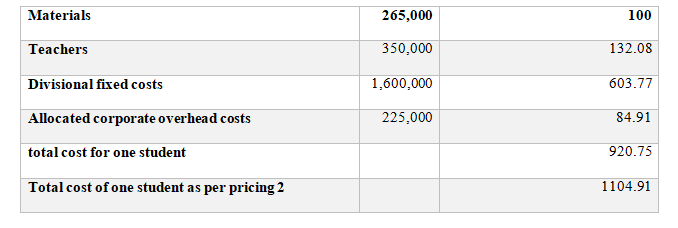CISE (Cirencester International School of English) Case Solution
Introduction:
CISE (Cirencester International School of English) is a UK-based Institution for the English language which has multiple divisions. The Bristol school is one of the divisions it has. It offers weekly courses to UK-based students and Non-UK base students. It got two levels one is intermediate and the other one is advanced level but the fee structure is the same for both levels which are $1000. This fee covers all the expenses of accommodation services except for meal service. The course is open from (Mon-Friday) and it operates 50 weeks a year. This institution has a rule of the group if which there should be 8 people in one group it can be classified by intermediate level and advanced level.
Part A
Question 1
Before Jessica, the number of students is 53 which has an inflow of $53,000.00 because the charges per course are $1000 and the total outflow of learning material expenses is $5300 due to which the net cash flow is 47700 but after Jessica’s enrollment, the number of students increased to 54 which impacted the inflow of learning material to 5400 so that the net cash flow will be $48,600.00 after Jessica’s enrolment.
Question 2
Before Jessica’s enrolment, the revenues were 53000 with the learning material expense of 5300, and the teacher pay per week was -6625 so after calculation, the divisional profit per week was 758.75 which has increased to 807.5 after Jessica’s enrolment due to which the additional bonus after Jessica has been increased to 48.75 because it has impacted the divisional profit.
Question 3
Before Jessica and the number of students per course is 8 and the number of classrooms is also 8 so by multiplying them the value of optimal capacity is found as 64 while the actual capacity is 53. The actual capacity (53) has to be divided by optimal capacity (64) to calculate expected capacity utilization. By doing this calculation it got 83%
Question 4
The total number of classrooms is 8 and this institution has 1 course per week so by doing the same calculation of multiplying the value of optimal capacity is 8 for one week. To calculate the actual number of courses for one week the actual number of students (53) has to be divided by the total number of the group which is (8). The value it shows (is 6.625). And after all these calculations the Expected Capacity Utilization is 83% too.
Question 5
As per the calculation, there is an expected utilization capacity of 66% with an actual capacity of 21 students, the optimal capacity is calculated by total number of students divided by two levels which is intermediate and advanced level. By doing all calculations it shows that there is enough space for Jessica to be enrolled.
Question 6
If Jessica has an advanced level of English then it will be difficult to find a place for enrollment because if you see the calculation for an advance level the expected capacity utilization is full which there no space for further enrolments is.
Part B
Question 7
The allocation rate for divisional fixed cost was 1600000 in 2018 and the total number of students was 2650 so by dividing the total fixed cost by the number of students, the allocation rate for divisional fixed cost for one student will be 603.77.
Question 8
The full cost of one student by using described cost system is 920.755 this calculation is done by adding all costs which include learning material cost is 100, the teachers costing is 132.08, the divisional fixed costs is 603.77, and the allocated corporate overhead costs is 84.91.
Question 9
After adding all cost from described cost system the cost for one student was 920.755 and according to pricing policy 2 the price for each student will be 1104.91
Question 10
Pricing policy 2 is better than policy 1 because whenever any student enrolled in any course, all cost will be included in their fee charges so BD will not have to worry about their expenses. Pricing 2 will also generate more revenue than policy 1 without increasing any expenses.
Question 11
Pricing policy can be improved by having a close eye on the profits margins because BD is an institution so if they use a credit hour fee structure it will be a better option for the Bristol division to enhance their cost savings
And for a better cost system if they schedule time table for the students and the teachers according to their class timing and if one teacher would teach more than one course it would cost less for rent as well as for the teacher because there will be fewer teachers than before for teaching the same number of students.
Part C
Performance measure is all good as per the analysis. Because it is an important aspect to get work done by the employee efficiently and effectively. Incentives are the main motivation because their performance is directly proportional to the institutions performance. These parameters increase the improvement of an employee’s life and future too. It will also increase the loyalty of the managers with the school which can help the school to retain them and save the cost of hiring new managers.
Conclusion:
This case was about pricing policy and enrolment capacity of Bristol Division which is a part of CISE (Cirencester International School of English). In this analysis it shows that pricing policy is better than pricing policy one because of the cost it incurred in the procedure 1 and also it shows the expected capacity of utilization of for intermediate and advance level separately so that institution will have a projection about students capacity. It also analyzes about full cost of one student from the total costing.....................
CISE (Cirencester International School of English) Case Solution
This is just a sample partial case solution. Please place the order on the website to order your own originally done case solution.























